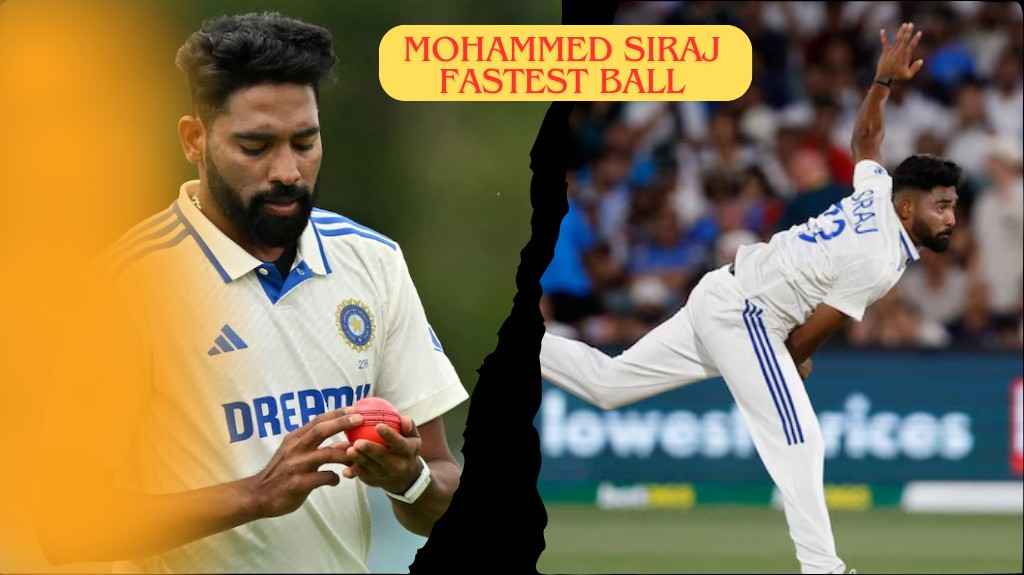Mohammed Siraj Fastest Ball Cricket fans across the globe were captivated by a curious moment during the second Test match of the Border Gavaskar Trophy between India and Australia. The match, held at the iconic Adelaide Oval from December 6–10, brought thrilling cricket action under the pink-ball spotlight. Amid a series filled with intense battles, Indian pacer Mohammed Siraj grabbed headlines for what appeared to be the fastest ball in cricket history.
| Match Details | Highlights |
|---|---|
| Series | Border Gavaskar Trophy 2024 |
| Match Type | Second Test Match |
| Venue | Adelaide Oval, Australia |
| Dates | December 6–10, 2024 |
| Special Incident | Mohammed Siraj’s 181.6 kmph delivery |
Mohammed Siraj Fastest Ball Astonishing Delivery: Fact or Flaw?
The second innings of the match saw India’s bowlers struggling to make inroads against Australia’s resilient batting lineup. While Jasprit Bumrah managed to secure one wicket, Mohammed Siraj, alongside debutant Harshit Rana, remained wicketless. However, during the 10th over of his spell and the 25th over of Australia’s innings, Siraj bowled a delivery that the speed gun clocked at an incredible 181.6 kilometers per hour.
The speed recorded left fans, commentators, and analysts in disbelief. Social media erupted with speculation, with fans wondering if Siraj had just shattered the long-standing record of Shoaib Akhtar, who bowled the fastest delivery in cricket history at 161.3 kmph during the 2003 ICC ODI World Cup.
Could Siraj’s Ball Have Rewritten History?
To put this into perspective, the fastest balls in cricket history, aside from Akhtar’s legendary delivery, have barely crossed the 160 kmph mark. Australian speedster Brett Lee, New Zealand’s Shane Bond, and England’s Mark Wood are among those who have come close, with their deliveries touching the 159-160 kmph range.
Bowling at 181.6 kmph is not just a quantum leap but a near-impossible feat in cricket. Experts quickly weighed in, pointing to the likelihood of a speed gun malfunction. Such technological glitches are not new in cricket and have previously caused momentary confusion among fans and players.
Shoaib Akhtar: The Fastest Bowler in History
For over two decades, Shoaib Akhtar’s record of 161.3 kmph has remained unbroken. Known as the “Rawalpindi Express,” Akhtar delivered his thunderbolt against England’s Nick Knight in the 2003 ODI World Cup. That remarkable over included several other fiery deliveries, clocking speeds of 153.3, 158.4, 157.4, and 159.5 kmph, showcasing his exceptional consistency.
No bowler in history has since come close to matching this feat, cementing Akhtar’s legacy as the fastest bowler cricket has ever seen.
Was Siraj’s Fastest Ball a Technical Error?

Although Mohammed Siraj fastest ball became a trending topic, cricket experts and commentators quickly dismissed the possibility of it being an accurate reading. Speed guns, while highly sophisticated, are not immune to errors. Environmental factors, calibration issues, or misalignment can sometimes cause incorrect speed readings.
In this case, the consensus among analysts is that Siraj’s delivery, while quick, was nowhere near the 181.6 kmph mark displayed. It is more likely that his ball was clocked in the 140-150 kmph range, which aligns with his usual bowling speed.
Mohammed Siraj’s Contribution to Indian Cricket
Despite the controversy surrounding the speed of his delivery, Mohammed Siraj has proven himself to be a key asset for the Indian team. Known for his relentless energy and ability to extract bounce and movement, Siraj has been a dependable performer across all formats.
Even though he remained wicketless in the Adelaide Test, Siraj’s effort and determination were evident. Moments like these highlight his commitment to the team and his ability to draw attention with his fiery spells.
The Legacy of Fast Bowling in Cricket
Fast bowling has always been one of the most thrilling aspects of cricket. Legends like Shoaib Akhtar, Brett Lee, and Jeff Thomson have brought crowds to their feet with their blistering pace. Records like Akhtar’s fastest ball remind us of the boundaries fast bowlers can push.
While Mohammed Siraj Fastest Ball may not officially enter the record books, the buzz it created reflects the passion cricket fans have for speed and excitement on the field.
Conclusion
The question of whether Mohammed Siraj Fastest Ball the fastest ball in cricket history may have been resolved as a speed gun error, but it sparked an engaging conversation about the evolution of pace in cricket. Shoaib Akhtar’s record of 161.3 kmph remains unmatched, standing as a testament to his unparalleled speed and skill.
For Siraj, this incident is another reminder of his potential to light up the game and his growing stature as a key player in Indian cricket. Fans will undoubtedly watch him closely, hoping for more unforgettable moments in the future.
With Mohammed Siraj fastest ball dominating the headlines, cricket continues to showcase its unpredictability and thrill, keeping fans eagerly awaiting the next big moment.
READ THIS ALSO
Redmi Note 14 Series Set to Launch on December 9: Price, Specifications, and Standout Features




